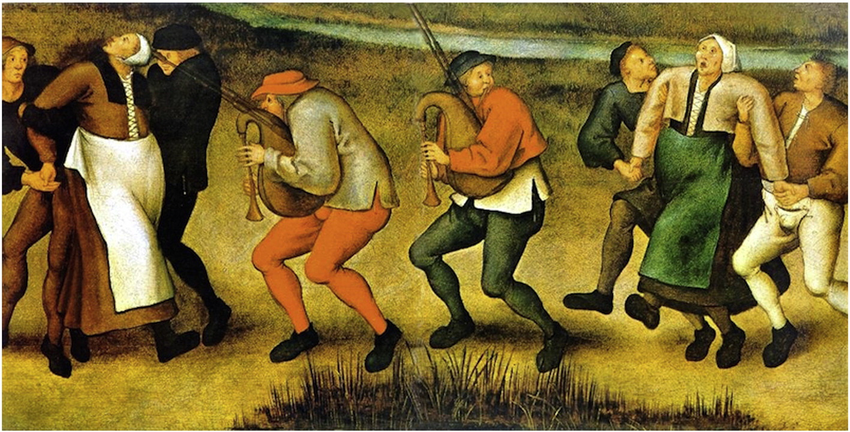Awakening the bodily situation
In this essay, we want to introduce a choreographic, self-reflective score for the labor of life: the deep work. Awakening the inner capacity to feel and act, we situate ourselves in action, and join the shared labor of making space. This is a combined protocol and analysis that simultaneously describes and enacts the awakening dance. Such dance is proposed to initiate a shift in cognition and a recomposition of thinking structures by activating bodily knowledge and resources. When reviving the body as a knowledgeable agent, its radiant potential communicates an embodied understanding of the world. Such awakening could fuel politics immune to commodification and the deadly extraction of the living.
Observation and stillness allow for inner and outer landscapes to intersect over time. It was a core practice of US-Americain choreographer Isadora Duncan (1877-1927), who situated herself as a body radiating between internal imaginariums and the natural forces that constituted her environment. She described a wave unfolding from within the body, toward the outside, and discovered her dance in a continuous flow of all things living—in cycles of perpetual rebirth and transformation. The state of dance was thus understood as being present to such flow. It became her method of study, of relating and of living as such.
When in her 1903 lecture[1] Duncan announced the coming of the “Dancer of The Future” she declared herself an indication for such future. According to her arguments, “The Future Body” must emerge from the state of dance[2] to build its cognitive horizon and vision on the practice of bodily awareness that awakes her to the one world in relation. In “The Future Body” a felt future is built through the deep work of consciously situated movements. Departing from Duncan’s body of work, we suggest the concept of The Future Body At Work. It is a method for studying, learning, and making dance, philosophy, and politics—beyond specific products or discourses.
Underscoring the living body as a muscle of thought, the score is activated through cycles of responses, and further expanded as a space for shared learning, in movement. This is a way to articulate the laboring body’s political history, starting in dance, viewed as the engine of this history. We search to establish a vocabulary that not only rewrites history, but one that also inscribes new meanings into words, references and historic events. By doing so, we develop a framework of thought in movement, departing from the social history of the body that unfolds into the future. We call this practice The New School of Dance. It is The Future Body at Work functioning as a container for collective recomposition of knowledge, and of the sense of solidarity and belonging with what is yet to come.
*
Breathe in. And breathe out.
The comrading space opening ahead of us calls in the common futures, while the hauntings of the past uncover sediments of violence and injustice upon which our present ground is set. As extraction surpasses the dead, those spectra continue to work in our imaginaries. In her essay “Returning to the Body Without Haunting”, Rosalind C. Morris asks: “What would it mean to get hold of a vision of the future from those who went before, and to think of it again, in terms of its possible coming into being?”[3] Instead of identifying with the dead, she suggests that we “ask how we might begin thinking about our present condition as one in which we no longer treat memory as a reflection on the past, but rather as an engagement of the future.”[4] And, we must add, it keeps us awake in the present.
The phenomena of the Dancing Plague of the early 15th and 16th century, having its final documented emergence in Strasbourg, France in 1518, are described to have consisted of large groups of habitants bursting out to the streets. Their outburst can be seen as a choreographic dissent that constituted a collective appearance in the public space—shaped by the dissonant individuals gathering and stepping into the dance. Dancing without a choreography imposed as an order of a reigning structure, seemed to be releasing the multitude from its daily labor’s struggle, while the intensity of the rave-like group is said to have drawn people in with a trance-like attraction.
Entitled both “plague” and “mania,” the multitude of individual bodies seems to have multiplied the sensation of inner recalibrating and signaled the force of bodies attempting to communicate outwards what was held within. While Isadora Duncan insisted on painless aesthetics, the dancers in Strasbourg were in pain. According to Andrew Hewitt, in the relation between the history of dance and of labor, ”a painful aesthetic is, indeed, wrong—but it also articulates that wrong”[5].
We may speculate about the importance of the ruptures which such early raves could have introduced in a feudal order—and how dance could have served as an expression of discontent and protest against the alienation and separation from life’s resources. In a choreographic sense, the gathering indeed blurred the lines between living and dying—as some of the dancers in fact danced themselves to death. Exceeding their own limits, they enacted the right to speak and act in public. In a shared effort they situated themselves anew.
***
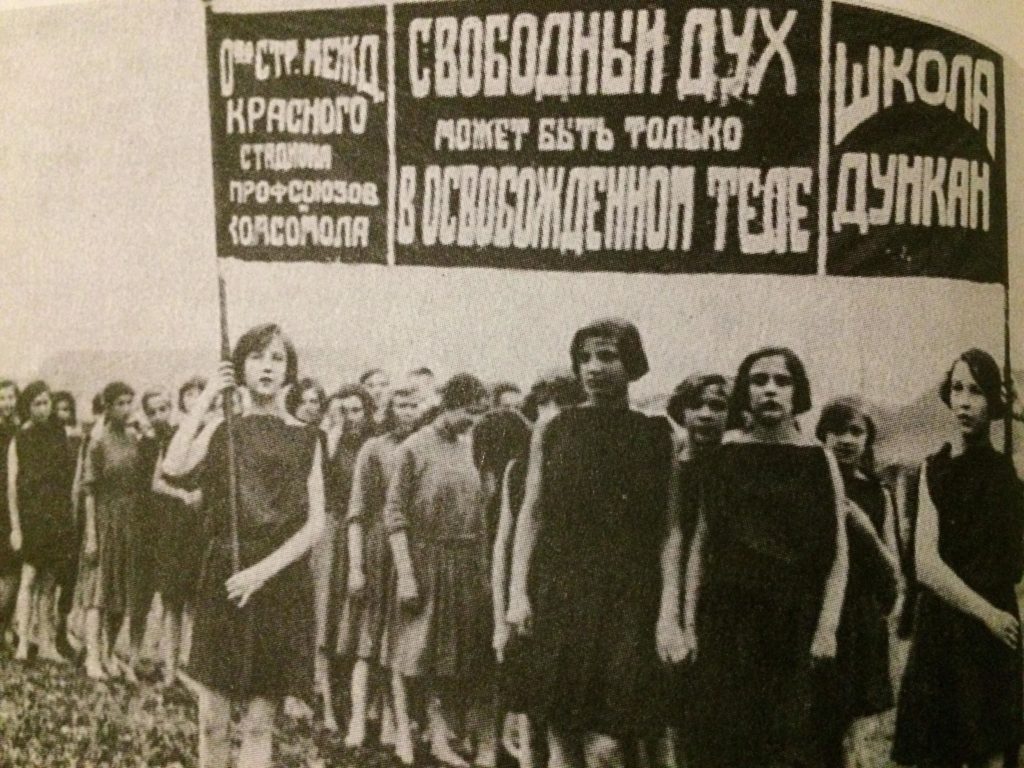
Isadora Duncan’s Moscow School at the Red Stadium, 1924 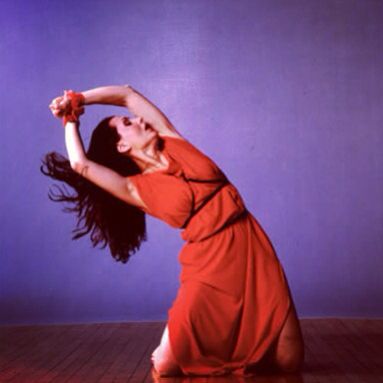
Jeanne Bresciani dancing Isadora Duncan’s The Revolutionary
“A Free Spirit Can Only Exist in a Freed Body[6]”
Shortly after the October Revolution in Russia, Isadora Duncan proposed modern dance as a language of the new socialist world. Declaring her solidarity with the working class and the Bolsheviks, she denounced her home country together with its elites that had been previously patrons and audiences of her art. The Revolutionary (1921) was one of her last choreographies. Within its composition, the dancer’s body moves between front and back of the stage—establishing an axis in space. As a wave breathing in and out, it contracts and releases past and future revolutionary gestures. Allowing for these remote times and spaces to mutually exist in the wave’s upsurgings and tides, The Revolutionary ambulates between emancipation and exhaustion to finally reach the front of the stage in a call for solidarity. Duncan indicates the transformation and announces the awakening of the “Dancer of the Future”.
The dance of the future was, according to Duncan, to be an expression of life founded on radical recomposition of one’s relation to what is knowledgeable. Thus, dance came to be a matter of mediation and communication, always happening in the sphere of the plural. The Dancer of the Future, then, would realize a choreographic plan aiming at developing subjectivity which moves beyond and away from preassigned modes and spaces of circulation[7] and through that establishes herself as a political subject.
We understand dance as the situation as well as the catalyst, the labor and the inalienable product. It makes space for the recomposition of tensions fundamental to the movement of relations and resonances that the work of the world implies. By means of hypertextual writing, formulations emerge beyond what is written, and the Future Body underscores and situates experiences of the worldly production.
This writing is thus not separate from dancing, but rather inherent to it. In entangled forms of languages we find ways to conceive a multidisciplinary study of the history of the laboring body. From these formulations we wish to enable a choreographic, self-reflective score for future becomings. The embodied agency proposed through and by an awakened body, reminds us of the proximity of feeling and thinking, subsequently shaping what Mark Franko described as “felt politics,”[8] which are essential to the emancipation from the capitalist regime of life at work.
As the name of our school implies, the score-based study practice departs from the Future Body. At Work, this body both recognizes and reconfigures the historical, present, and future conditions of its inherent and interrelated activities. Working through surrounding structures as well as from internal networks of stories and shapes that last beyond the body’s physical bounds—the Future Body composes these, dancing.
The Future Body remains at work in the continuous movement of recompositions through and with the world of social, political and economic inter-dependencies. We argue that “movement” is what engenders the body and what sustains it in the flow with others. The awakening concerns our becoming present to that movement. If the Future Body is a dancing body, we must recognize it as being an engine and a place for livable worldly production. As such, it is a feeling and thinking space in which we take place, and from where we are. We become present to ourselves in movement. We incite dance.
*
You sit, stand or lie down. Feel the time that resides in your muscular memory as you move across the lines of this text. The letters connect to your fibres while your eyes move along its phonetics. Relax deep into the cone of your eye socket. Imagine a line that runs between your ears. Back to where the skull rests. Nod softly. Your skull rocks on the very top vertebrae, the atlas. It is crowning the spinal column—a string of pearls at the core of your body. When you nod, the skull reminds you of all parts being interconnected. As the inner landscape of bones is hidden from feeling, let the sensations around the bones define it.
“You’ve been swimming in gravity since the day you were born. Every cell knows where down is. Easily forgotten. Your mass and the earth’s mass calling to each other…”[9]
Imagine a shifting of balance between movement and stillness that occurs in each moment. Imagine what work carries this oscillation forth. The deep work of social interaction and of remembrance. Imagine the work that produces commons and commonalities. Your relation to the world is in continuous motion, expressing the proximity of cells and the shimmering of bodily matters as it leaks beyond your skin, bleeding into your surroundings.
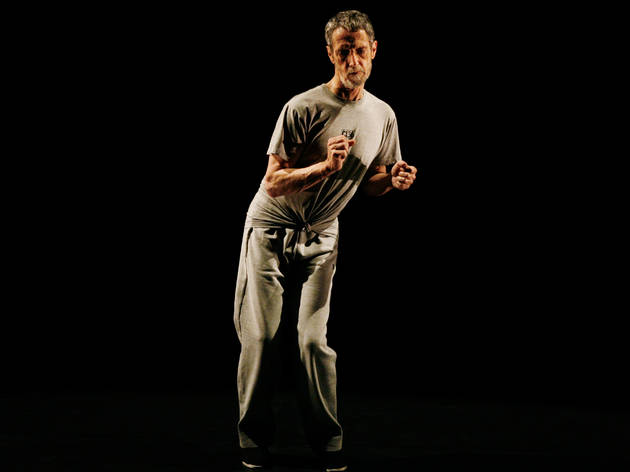
Steve Paxton 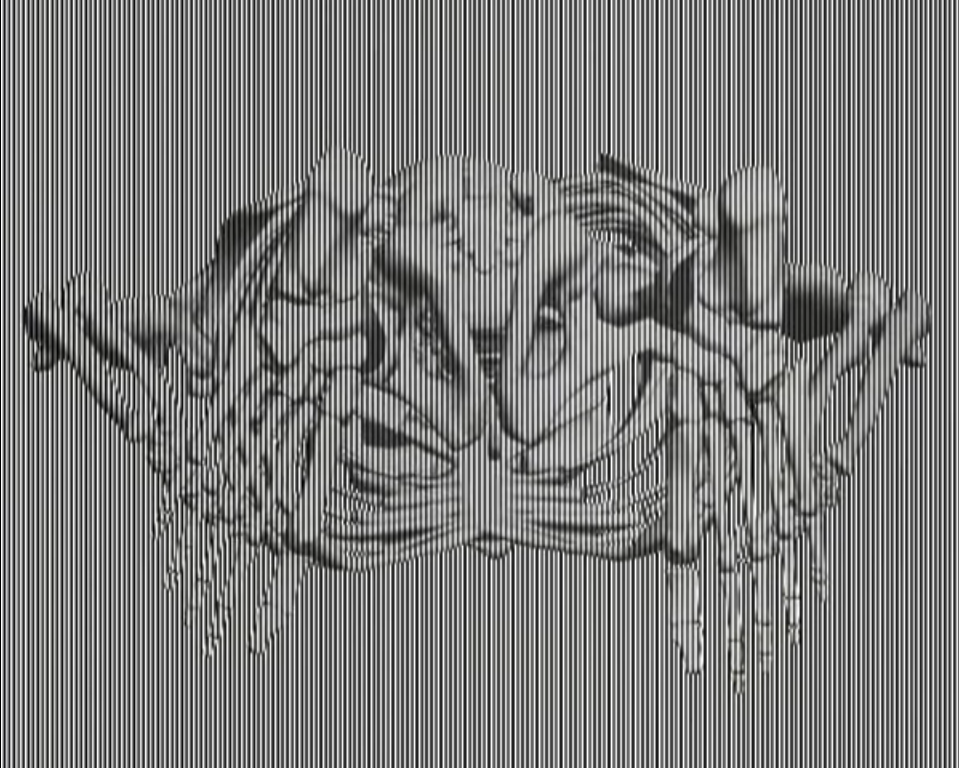
Small Dance Video Still
In his Small Dance practice as described in a publication from 1977,[10] US-American choreographer and dancer Steve Paxton ambulates between doing and non-doing, as he sets focus on the labor of life itself. Dance occurs “in the midst of standing still,”as Paxton puts it, reproducing the non-productive, by simply remaining with what is.
As described by Yvonne Rainer,[11] Paxton ”marks” the movement phrases with sketching gestures, without completely fulfilling them. They are initiated, suggested, exercised but never fully expanded. They sketch possibilities in space. In Yvonne Rainer’s words, his performances ”blurred boundaries between consecutive movements[12]”. Andrew Hewitt suggests that ”performance always performs yet erases its own boundaries (…). [It] obliges us to dialectical thinking in ways that the unhelpful dichotomies you rightly outline do not.”[13] To think life, we have to go beyond our own imaginaries.
Paxton’s Small Dance teaches us how to become present to what already is, as we acknowledge the movement that constitutes the body and the balancing of its structures that conditions any other movement. Such a careful observation also reveals the history of a body—the depth of its layering, tides of sensations, memories and textures. When practicing Small Dance, the spinal recalibrations secure our upright position and take place in relation to all structures of the body while they also become situated in relation to the surrounding space. The practice serves as a preparation for contact with the body field of others. Self-knowledge is acquired to be further applied, through the responses to the actions of others, and to the situations unfolding in dance improvisation.
The bodily situation is inscribed onto the kinetic realm, bigger than a singular body. It is determined by forces and imaginaries that interweave the dancer with other bodies of various kinds and origins. In such a fleeting universe of recalibrating physicalities, we all gravitate toward one direction, we all share a centre. From this place we can revive relations of solidarity that inform our socio-political stand. We thus understand Comradery as a choreographic strategy of making and holding space. Comrades recognize each other in a shared space. Or, as Jodi Dean puts it: “Comrade (…) is a mode of address, figure of political belonging, and carrier of expectations for action. When we call ourselves comrades, we are saying that we are on the same side, united around a common political purpose.”[14]
***
If recovering our ability to think is essential to unveiling and reconstructing the world in common,[15] we must seek ways of mobilizing all our cognitive resources and abilities. Thus we can dedicate ourselves to reconsideration of the spectrum of relations upon which we rely. To let our existence amongst others unfold beyond ourselves, we must be ready to give up some of the preconceived notions of belonging. Returning to the world in comradery with others, we reveal that fundamental interdependence of our bodily selves.
In the space that unfolds through dancing together, we test social conditionings and experiment with modes of relating and circulating as subjects. Dancing, we discover the challenges and joys of engagement and continuously enter the spheres of unknowing where we find ourselves anew alongside the movements of others. We practice together by continuously recomposing ourselves. Social change requires inner change. This is a deep work, stretched through time and various spheres of cohabitation.
In the Future Body, the labor of generations crystallizes as movement of freedom, a sign of life—sustained and engendered collectively. It is “the miraculous coming into the world of the highly improbable”[16]when the choreographing of the world in motion stems from our social and collective intelligence that counteracts separation of bodies from their liveability and their creative capacities. Exchanging dispossession for the disposition of responsibility, care restores what was damaged. But awakening does not mean a restoration of the past, nor a discovery of an ‘essence’ or truth of any sort. It is not a process of reinstating of boundaries, but a socio-political and historic flip of logic that allows us to think about the future as an ascent to life rather than death.
Dancing must be understood primarily as a practice of the body acquiring consciousness and becoming present to itself. This is a first step toward a revolution of thinking—what follows is the emergence of the space of dance (and of comradery) understood as the experimentation in recovering the world in common by acting choreographically upon relations that demand recomposition as reparation. If the choreography is a “technology for inventing movements of freedom,”[17]we may seek in the sphere of dancing a seed for new conditions of being. The task of the Dancer of the Future then is to transmit techniques and structures that bring forward the corporeal knowledge and the awakening of the political subject that dances her way out of repression and conformity—so is the Dancer of the Future, the indication and the enactment of the Revolution.
Reading while writing, the Future Body sustains itself through the alignment of the intrinsic forces of bodies. Resonances move like waves that contest what lasts —by engaging with it. Thus the Future Body exists beyond stable writings of history, and allows for transformative communication. It enters the logic of time to recompose it and to reveal the inherent human capacity to move and to emerge from movement.
[1] The lecture is believed to have been presented in Berlin as Duncan’s first school of dance was founded in Grunewald—today one of the southern districts of Germany’s capital. Isadora Duncan, ‘The Dancer of the Future’, The Art of the DanceNew York: Theatre Arts Books 1902, [1928].
[2] Simone Forti, “Animated dancing. A practice in dance improvisation,” in: Contact Quaterly 26:2 (Northamton: Contact Collaborations 2001), 32-39.
[3] Rosalind C. Morris, “Returning the Body without Haunting,” in: Loss. The Politics of Mourning, ed. David L. Eng and David Kazanjian, Berkley, Los Angeles and London: University of California Press 2003, 30.
[4] Ibid.
[5] Choreography is a way of thinking about the relationship of aesthetics to politics. Andrew Hewitt
interviewed by Goran Sergej Pristaš”. Frakcija, https://thefuturecrash.files.wordpress.com/2008/07/andrew_hewitt.pdf (20 October 2019)
[6] Slogan from the banner held by students of Duncan’s Moscow School at the Red Stadium in 1924.
[7] Andre Lepecki, “Choreopolice and choreopolitics”, in: TDR/The Drama Review 57:4 (New York: MIT Press 2013), 20.
[8] Mark Franko, The work of Dance. Labor, Movement and Identity in the 1930s, Middletown: Wesleyan University Press 2002, 40.
[9]Steve Paxton: Small Dance Guidance etc…, available at: https://myriadicity.net/contact-improvisation/contact-improv-as-a-way-of-moving/steve-paxton-s-1977-small-dance-guidance, (20 October 2019).
[10] Steve Paxton, “In the midst of standing still something else is occurring and the name for that is the small dance”, Theatre Papers. (Dept. of Theatre, Dartington College of Arts, 1977).
[11] Yvonne Rainer, “A Quasi Survey of Some ‘Minimalist’ Tendencies in the Quantitatively Minimal Dance Activity Midst the Plethora, or an Analysis of Trio A” [1966], in: Minimal Art: A Critical Survey, ed. Gregory Battcock (Berkeley and Los Angeles: University of California Press, 1995 [1968]), 269.
[12] Ibid.
[13] “Choreography is a way of thinking about the relationship of aesthetics to politics”. Andrew Hewitt
interviewed by Goran Sergej Pristaš. Frakcija, https://thefuturecrash.files.wordpress.com/2008/07/andrew_hewitt.pdf (20 October 2019)
[14] “The Comradely Professor. For Jodi Dean, the class war is on—and academics need to pick a side”. In https://www.chronicle.com/interactives/20191011-ComradelyProf?cid=wcontentgrid_hp_6&fbclid=IwAR3Zwf1CSYssTXojBJXDQ7Q0o_OpPZPrrBBME7QUEF15ZyhKb3k7HblDyuA. (20 October 2019)
[15] Sindre Bangstad and Torbjørn Tumyr Nilsen, “Thoughts on the planetary: An interview with Achille Mbembe,” in: New Frame, 5 Sep 2019. https://www.newframe.com/thoughts-on-the-planetary-an-interview-with-achille-mbembe/ (20 October 2019)
[16] Hannah Arendt, The Human Condition, 1998 (1958), Illinois: University of Chicago Press 1998 (1958)), 175.
[17] Andre Lepecki, 2018, 8.
